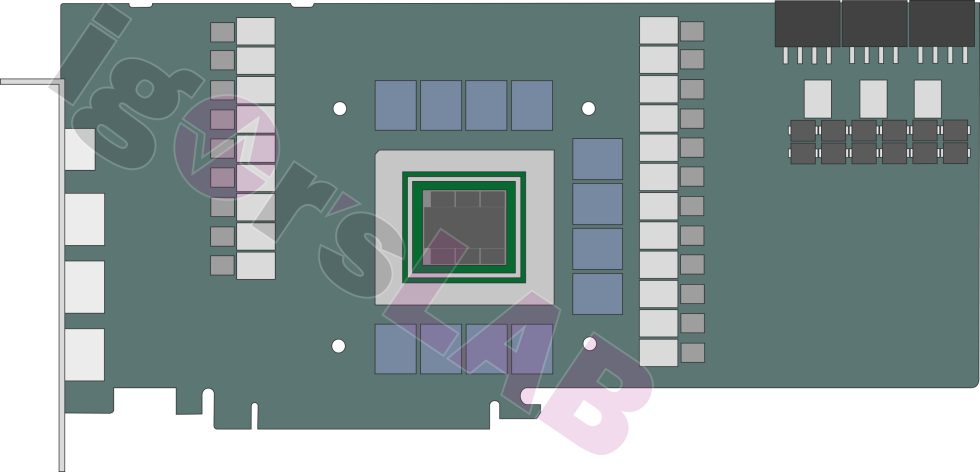While the protagonists of the sensational leaks are currently fighting among themselves and wrestling for the ultimate interpretative sovereignty of NVIDIA and AMD products, I grabbed a bag of virtual popcorn and first read along with amusement. The silly thing about the whole Twitter controversy is that many things may even be true at the time of the leak, but they can change on a daily basis. Especially since both manufacturers also deliberately use nice smoke candles to confuse the rest of the world. I already wrote something about this recently.
There are almost daily leaks and new pictures of NVIDIA’s RTX 4xxx series, but it has been surprisingly quiet about AMD’s new Radeons with RDNA3. And since I like drawing circuit boards, I used all the information I received and looked for the lowest common denominator for the upcoming Radeon RX 7900XT. I admit that my drawn “artwork” is based on real circuit boards and blueprints, but they are not for public consumption. But I can sleep at night with a clear conscience, because without publishing genuine originals, on the one hand I can protect my sources well, and on the other hand I don’t hurt the manufacturers too much, but only satisfy the information needs of my readers.
The following graphic shows the board of a Radeon RX 7900XT as a possible board design very close to the reference. I changed the dimensions and aspect ratios a bit, compared different designs, and only adopted what proved to be constant. Most of the holes vary greatly in the individual designs, so I deliberately omitted them. However, many details are congruent and recurring, so they can be considered set. And for those who remember my drawings of Turing and Ampere, they ended up being almost photographically accurate. So today we have the RX 7900XT as a virtual forecast:
Let’s summarize what I noticed about all of the designs, which is based on CAD drawings, photos, and text descriptions:
- The Navi31 GPU of the RX 7900XT relies on a total of 6 MCD chiplets and one GCD chip (I’ll leave the detailed data to the Twitter kings here, but they were quite good lately).
- 12 GDDR6 modules are used, which suggests a memory expansion of up to 24 GB
- There are (besides the usual low and partial voltages) 21 large voltage converters installed in my example, which could be divided as follows if AMD keeps the usual supply scheme: 16 voltage converters (from 8 phases running in parallel) for VDDC_GFX, 2x memory, 2x VDD_SOC and 1x VDDCI. The card would therefore be supplied with 8 phases, which is in line with the general trend (also at NVIDIA). By the way, this is not a speculation, but a real circuit design, but I do not want to go into detail.
- In the left third there are the various voltage transformers for the partial voltages and below the voltage transformer row also the input filtering for the slot (12 volts and 3.3 volts), which I also left out for the reasons already mentioned.
- We recognize 1x HDMI and 3x Displayport, USB-C is not on board
- A total of three tracks on the external PCIe power supply supply the card’s voltage converters and each of the tracks has an LC combination of coil and upstream polymer caps as output filtering against high-frequency load peaks
- In the presumed board design, we see three 6+2 sockets instead of the 12VHPWR. I’ll leave it open whether this PCIe 5.0 connector will make it onto the final cards.
- However, this also limits the maximum board power of the card to 450 watts, whereby the actual TBP should be far below that.
As I wrote before, everything is in flow and can change almost daily. What I have included in the drawing is constant for a long time. It’s not quite complete yet, but it’s already somewhat meaningful.
Twitter contention?
Some time ago, I explained why the tweeted water level reports are often not worth the power that was used to feed the executing PC. The manufacturers are currently doing everything they can to camouflage, confuse and deceive. This has almost Putinian secret service qualities. And that’s exactly why I’m deliberately holding back with a lot of information at the moment. With some of them I know that they are true, but things can still change, with other pieces of the puzzle, skepticism prevails, whether something like this has not been purposefully scattered. The leaker business has become really tough. You are currently offered more than you would like to believe. The only thing is that you almost never know what you are actually posting. I stay out of such Twitter discussions, because it only falls on one’s feet unnecessarily anyway.
|
|
































62 Antworten
Kommentar
Lade neue Kommentare
Mitglied
1
Urgestein
1
Urgestein
1
Veteran
Veteran
1
Urgestein
Urgestein
1
Urgestein
Veteran
Veteran
Veteran
1
Veteran
Urgestein
Alle Kommentare lesen unter igor´sLAB Community →